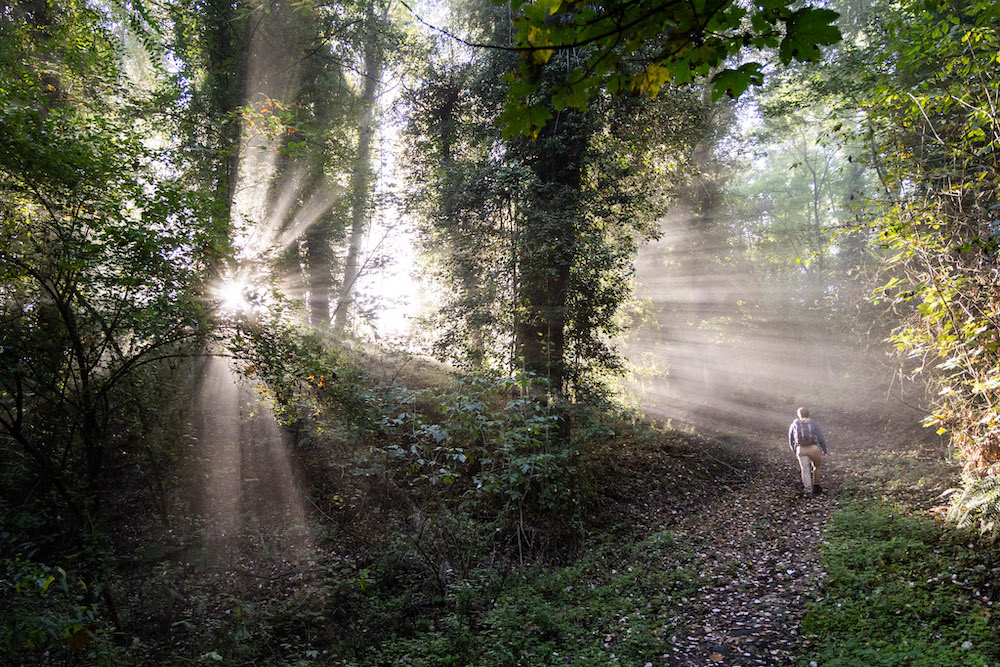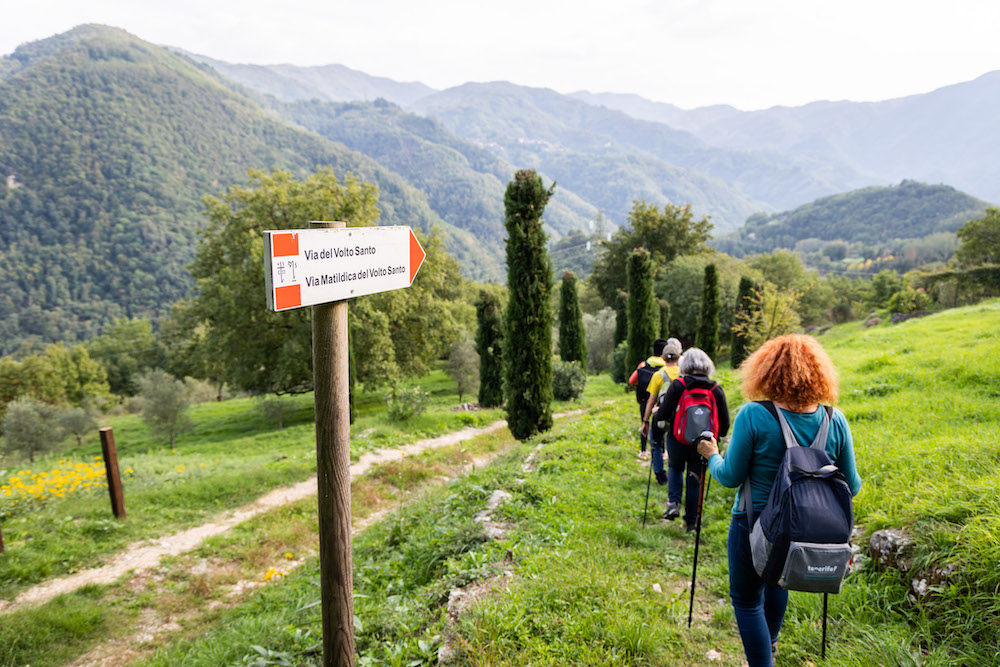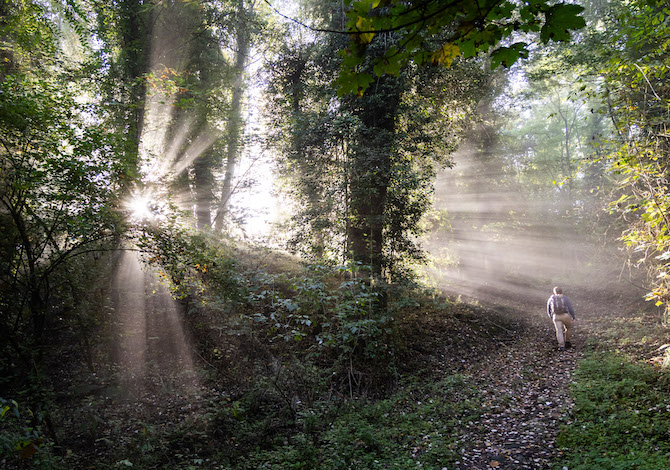Among the many ancient routes traveled by pilgrims of yesterday and today, it absolutely deserves the Via degli Abati and the Holy Faceil I walk that a stages from Pavia va a Romaconsidered the Apennine variant of the Via Francigena. The history traces it back to VII centurywhen he imposed himself on map of devout itineraries such as the shortest route and Pavia to Lucca towards Rome and was used for the movements of the Lombard sovereigns and the emperors of the Holy Roman Empire, as well as the monks of San Colombano di Bobbio for their commercial exchanges and their visits to Rome by the Pope, on whom the abbey depended directly. Today it is one of itineraries more interesting to do on foot, a path which allows you to discover the nature of Italy between Lombardy, Emilia and Tuscany, its villages and hospitality, but you can also travel by bike. And as in many other paths, it has its own Credential for those who participate. Here we point out the stages from Pavia to Pontremoli, to be done with a map guide in tow.
Via degli Abati, from Pavia in the footsteps of the monks
The Street of the Abbots classic winds on a length of about 195 km touching the Lombardyl’Emilia Romagna and the Tuscany. And Pavia it passes through the Oltrepò hills and Monte Penice up to Bobbio. From Bobbio continues towards Pontremoli, last stop. Cross valleys and ridges for a total elevation gain more 6,000 meters.
Those who want can continue along a last stretch known as the Path of the Holy Face up to Lucca, savoring not only the beauties of Lunigiana but also those of Garfagnana.The traditional Way has its fulcrum in theSan Colombano Abbey, where the remains of this great Irish abbot are kept. which with San Benedetto is considered the father of European monasticism and which has always been the object of profound veneration by French and British pilgrims on their way to Rome.
In addition to the travellers religious the Street of the Abbots he knows how to fascinate too those who are not believers but who, living in the city, wish to experience or rediscover the pleasant sensation of walking up paths and mule tracks that have remained almost unchanged over time in still “virgin” Apennine areas. They increase its power of attraction history and culture that characterize the places you meet ei genuine flavours of a traditional cuisine never gone out of fashion, combined with simple but cordial hospitality.
Via degli Abati, the stages of the route from Pavia to Pontremoli
The route of the Street of the Abbots today it is passable a feet, a cavallo o in mountain bike with small variations compared to the historical route, due to landslides and stretches of road that no longer exist. It can be divided into 8 stages that require 8 days.
1- Pavia – Colombarone (23 km – 7h)
2- Colombarone – Walk (20 km –7h)
3- Hike – Bobbio (25 km – 8h)
4- Bobbio-Mareto (22 km – 8h)
5- Mareto-Groppallo (16.5 km – 6h)
6- Groppallo-Bardi (21,2 km – 7h)
7- Bardi – Borgo Val Di Taro (33,3 km – 10h)
8- Borgo Val di Taro – Pontremoli (33,9 km – 10h)
Via degli Abati: the itinerary up to Lucca with the Cammino del Volto Santo
Once in Pontremoli you can continue with the Cammino del Volto Santo, which from Lunigiana through the Garfagnana reaches up to Luccathen flowing into the Via Francigena towards Roma.
If you opt for the entire route from Pavia to Lucca, the total route amounts to 350 km, who usually come divided into 18 stages.
Only the Camino del Volto Santo is feasible in 10 tappe and can be accomplished by unhooking it from the first part of the itinerary.
Via degli Abati: the stages from Pontremoli to Lucca
Compared to the more significant destinations for Christianity – such as Jerusalem, Rome and Santiago de Compostela – that of the Holy Face is a minor destination, but offers the possibility of fulfilling a devotional experience even to those who cannot afford distant and excessively tiring journeys.
Its name comes from a wooden statue preserved in the cathedral of San Martino in Lucca which is said to have been sculpted by Nicodemus (the one who placed Jesus in the tomb with the help of Joseph of Arimathea) and whose head would have been made by angels while he slept.
Below is the list of 10 stages:
1- Pontremoli – Lusignana (18 km – 7h)
2- Lusignana – Bagnone (14 km – 6h)
3- Bagnone – Monti (22 km – 8 hours)
4- Monti – Fivizzano (17 km – 6h)
5- Fivizzano – Argegna (20 km – 6h)
6- Argegna – Piazza Al Serchio (11 km – 5h)
7- Piazza Al Serchio – Castelnuovo di Garfagnana (21 km – 8h)
8- Castelnuovo di Garfagnana – Barga (27km – 9h)
9- Barga – Borgo a Mozzano (21 km – 8h)
10-Borgo a Mozzano – Lucca (28 hm – 9h)
Tips for walking the most beautiful paths in Italy
Via degli Abati: main info
Il path of the Via degli Abati non presents generally particular technical difficulties. The level of difficulty is related more to the length and al difference in level of the stageswhich mainly develop on paths, mule tracks e white roads.
They are available to travellers, all along the way convents, hostels, parishes, B&B, farmhouses e hotels of various level.
Via degli Abati: what to see along the way
The section of the Via degli Abati from Pavia to Caminata towards Bobbio it is of the flat and hilly type with paths, mule tracks and dirt roads. Here the historical importance of centers such as Pavia and Bobbio, with its famous San Colombano Abbeyintertwines with the geometric beauty of the Oltrepò Pavese vineyards Bobbio in Pontremolipassing through Bardo and Borgo Val di Taro, the route is mountainous.
Of particular scenic and cultural interest in this stretch are the Pass of the Sella dei Generalithe highest point of the Via (alt. 1217 m), the Mount Lama already inhabited by Neanderthal man and famous for its red jasper stones, the Fortress of Bardithe Parish Church of San Cristoforothe Borgallo Forestil panoramic ridge which runs between Emilia and Liguria, le Pisciarotta waterfallsil Green lake and finally a Pontremoli the Museum of the enigmatic Stele Statues and the labyrinth of San Pietro, a true symbol of the paths that lead to the elevation of the spirit.
Worth noting not far from Borgo Val di Taro the Ghirardi Nature Reserve, which protects a corner of the Apennines that has remained unchanged over time. The particular morphology of the territory creates the conditions for different habitats ideal for many animal species, including hobby falcons, nightingales, warblers, sparrowhawks who prefer downy oak woods, while owls nest in the chestnut groves and wild boars and roe deer hide. In primavera e in estate you can admire hundreds of flowers, including the rare Ophrys bertolonii.
The Path of the Holy Face in Via degli Abati
Also the last part known as the Path of the Holy Face it winds mainly on mule tracks, some of which still retain their original surface today, while the rare paved roads have little traffic. The territories have a unique conformation with enviable landscapes and a nature rich in flora and fauna, typical of the Lunigiana and of Garfagnanaboth of which enjoy the contextual presence of the Apennines and some Apuan Alps.

It is a path littered with ancient villages and centres with castles that narrate captivating stories and traditions, legendary churches and bridges: the medieval town of Bathroom with beautiful views of the impetuous Bagnone stream, Fivizzano considered the Florence of Lunigiana, Castelnuovo di Garfagnana with the Rocca Ariostesca and the Montalfonso Fortress, Barga with its narrow streets, Borgo a Mozzano with the famous Maddalena or Devil’s bridge.
And lastly Luccaso ancient and splendid in terms of history and art that it is known everywhere in the world and where, after so much effort, it is finally possible to venerate the Holy Face.
Via degli Abati: the ultra-trail race “The Abbots Way”
Those who feel like it can organize the path of the Via degli Abati in conjunction with the gara podistica ultra-trail “The Abbots Way” of 105 km, one of the most important ultra-marathons in nature which takes place in May from Pontremoli to Bobbio, conceived and organized by the marathon runner Elio Piccoli, now also president of the “Lupi d’Appennino”. Since 2009 the route has been brought to 125 kmcon due gare separate: one with an intermediate stop in Bardi and the other with a single route.
Via degli Abati: how to organize the journey
Per plan the Via degli Abati in the best possible way it is useful to read up by consulting the various websites including www.viadegliabati.comget some cartoguide (available only for the Bobbio-Pontremoli stretch) and the credemptive (which certify the completion of the course). Tech-savvy people can download the track for GPS or for the Smartphone.

It is also advisable to know the difficulties that the route presents in order to reach the destination in the best psycho-physical conditions, fully savoring everything that the itinerary offers step by step, as well as knowing in advance where to stay taking into account the reasonably practicable distances.
The guide to make the Via degli Abati
In bookstores you can find the new one “Guide to the Via degli Abati”, published by Terre di Mezzo, with the complete route from Pavia to Lucca; offers 8 stages and is complete with maps, images, history, descriptions, routes, places to visit, welcome and refreshments.
Photo Matteo Dunchi for Toscana Turismo
Advertising
